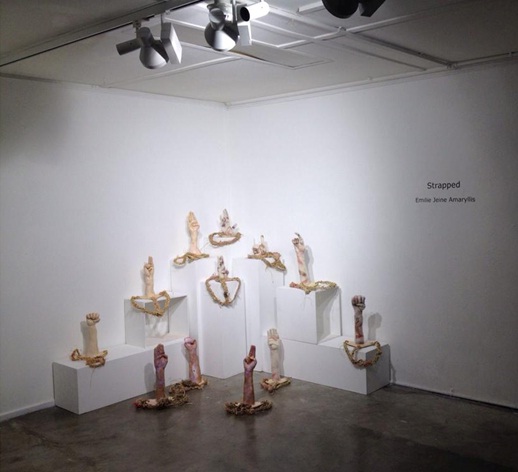strapped: art challenging phallocentrism’s impact on lesbian sexuality

Image © Emilie Jeine Amaryllis
Not everyone wants a ‘bulbous veined dick’ inside them. With this in mind, Newcastle-based artist Emilie Jeine Amaryllis has replaced the phallus with fists and other gestures in an installation resembling strap-ons.
‘Patriarchy and penises are everywhere and as a feminist lesbian, I want to challenge these things,’ Emilie says of the exhibition, which aims to call out less visible forms of sexual repression in our society.
There is no denying a large portion of human sexuality is fixated on the male sex organ. This is the case to the extent of sex education often providing scant information on lifestyles beyond the realm of heteronormatives. For some lesbians and same-sex attracted women, it even means they feel their sexuality is not valorised. As a lesbian friend once said to me of having to live in a phallocentric society, ‘I just wanted to know my sexual orientation was valid…wasn’t less than because a penis wasn’t involved’.
As explained in Strapped’s exhibit notes, likenesses of the penis are often thrust upon same-sex attracted women through limited choice in sex toys, such as vibrators, dildos and – as is Emilie’s focus – the strap-on (a harnessed toy designed to imitate the male organ on users without a functioning one).
‘Sex toys were initially a male-constructed device and still have a strong masculine presence in their marketing, although they are [often] products for women,’ the exhibit points out.
Emilie’s installation confronts both the esteem awarded to the phallus and the social inequality afforded to lesbian sexuality in the symbolism of her installation.
‘It combines queer and feminist theories in art practice to challenge preconceived notions [of sexuality] in society to the audience and pose questions as to why sex can only be authentic when a penis or phallic symbol are involved,’ Emilie says. ‘This questioning of culture empowers women as they realise they can have agency in their sexual experiences.’
Using ceramic, paper and felt, the artworks – which consist of pastel and nude shaded arms with a natural fibre harnesses – present an alternative perspective of female sexuality to the coldness of the strap-on. This represents ‘elements of femininity as opposed to the intimidating and constructed nature of hard plastic used for sex toys’, Emilie says.
Not all gestures seem to be concerned with an overt symbol of resistance. The striking nature of the fists (Fist fuck her) is contrasted with two fingers (Two finger fuck her), among other dextrous arrangements. Emilie has chosen the shapes to highlight that ‘for solidarity and resistance against phallocentric culture or during sex, it [making the gestures] still feels fucking good’.
The installation stands with pride, with works on the floor and on a multi-levelled display in the corner of a white room, somewhat like a shrine. The exhibition also features shadow play with the silhouettes of the strap-ons expanded on the walls behind them. In this sense, the installation seems to celebrate and reclaim not just lesbian sexuality, but the physical exhibition space as female.
Strapped is showing at the University of Newcastle’s Watt Space gallery until August 17. You can catch more of Emilie’s work on her website.


Woah! I never thought about this! Truly excellent artwork. Thanks for sharing Sarah.
Aren’t they still, essentially, phalluses? Just because it is not explicitly a penis, doesn’t mean it isn’t phallic.